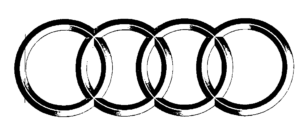The debate over the protection of the iconic “AUDI” logo in Poland is currently being renewed (see here). An injunction was sought by AUDI to stop another party from importing, offering, marketing, and advertising radiator grilles that bear a sign that is identical to or similar to its EU trade mark (“EUTM”) for the following mark:

No 000018762
The radiator grilles offered by the defendant bore devices that were meant to allow the four interlocking circles to the grilles, and these devices had a shape that was arguably identical to the four interlocking circles as such. The IP Court in Warsaw was wondering if the trade mark right also covered the elements for affixing an infringing sign to an automotive part (see referral C-334/22).
„Repair-clause“ in trade mark law?
The “repair clause” in design law does not have an equivalent in trade mark law. This matters 1) where the trade mark owner also owns a Community design, and 2) where the trade mark owner is the sole manufacturer of the original part. In both situations, the question is whether the exclusive right to the trade mark may prevent others from manufacturing and selling the spare part. According to the referring court, the “repair clause” means that, under some circumstances, the manufacturer of the non-original component is allowed to produce this despite the Community design. As the “repair clause” is an expression of the freedom of competition, in the opinion of the referring court, trade mark protection should not grant the owner the exclusivity denied by design law. The IP Court argues that Article 110(1) of Regulation 6/2002 (‘repair clause’) is effectively reduced to zero if the manufacturer of a non-original part is prevented from using the trade mark of the original part while also being prevented from using its own mark or manufacturing and offering for sale parts without any mark or with its own sign. Therefore, it is unclear whether manufacturers are allowed to produce and sell spare parts with a trademark. The referring court doubts whether the case law up to this point may support the idea that affixing a trade mark to a part other than a wheel cover should be regarded as having no origin function. Note, however, that the CJEU already ruled in Ford Motor Company, C-500/14, that the restrictions of design law could not be read into trade mark law. The restrictions of trade marks in the interest of competition are laid down in the appropriate provisions of trade mark law on exclusive rights and limitations thereof (now: Article 9, 14 EUTMR) and it is not possible to restrict trade mark protection beyond these provisions on the grounds of design law, in particular the “repair clause” (Ford Motor Company, paras. 39, 43).
Referred questions
The IP Court in Warsaw submitted four questions to the CJEU, all in essence asking the CJ to further clarify the relationship between design law restrictions through the repair clause and the scope of trade mark protection. The first question is whether, under Article 14(1)(c) EUTMR (=fair referential use), a sign that is protected by an EUTM can be applied to a radiator grille as a mounting element for an emblem (in turn, the sign protected by the EUTM), and whether it makes a difference for this question if the mounting element, for technical reasons, has to replicate the EUTM or not. Second, if such use were in principle covered by fair use, the court would ask what the criteria are to assess whether the use is consistent with honest practises in industrial and commercial matters. The third and fourth questions ask if the use of a sign as a mounting element, as described above, might not be a trademark use at all, since the sign doesn’t have an origin function in that situation.
Comment
The factors that should be taken into account in determining whether the “Audi” trade mark is used at all and whether such usage is in accordance with honest practises in industrial and commercial matters should be established bearing in mind the relationship with the aims of the “repair clause” in Community design law. The CJEU may say that the national court’s factual and normative assessment should take into account the rights holder’s interests, including that it has no control over the manufacture of the car part and its compliance with safety requirements. On the other hand, interpreting the law in a way that lets trademark protection stop the production of non-original parts would defeat the purpose of the repair clause in design law, which is to protect competition in this important aftermarket.
_____________________________
To make sure you do not miss out on regular updates from the Kluwer Trademark Blog, please subscribe here.


